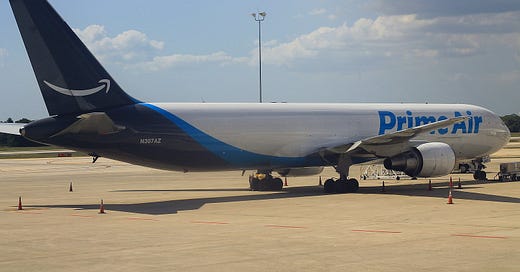What Happens When You Shut Down Amazon’s Main Air Hub?
An analysis of the recent KCVG closure through the flight counts
On January 5th and 6th, 2025, Winter Storm Blair shut down Amazon’s main air cargo hub, KCVG in Cincinnati, as well as its auxiliary air hub in Wilmington, OH. These twin hubs are what Memphis is to Fedex, and what Louisville is to UPS. On a normal day, about ⅕ of all Amazon Air flight takeoffs happen at KCVG/KILN.
In their 10-K reporting, companies will often speak of weather and labor in the same section, and for understandable reasons: Winter Storm Blair gave us a peek into what Amazon would do in the event of a 100% out strike at its main air cargo hub. So what did they do?
To figure out a piece of an answer to this question, I pulled flight data on all Amazon Air flights from flightradar24.com between December 29, 2024 and January 13, 2025—one week before, and one week after the KCVG closure. The comparative data for the week before is a bit messy because a) we were still coming out of peak and b) of New Year’s holiday, when there were no flights. Still, you can get a pretty good idea of what happened by the flight counts.
If you asked me ahead of time, I would have guessed that they ran their other key hubs hot for a few days; that is, you would have seen increased activity at Amazon’s other regional hubs in San Bernardino, Fort Worth, and Lakeland. This wasn’t the case: all three hubs saw about the same amount of flight activity on those two days as usual.
In fact, it doesn’t seem like Amazon did a whole lot in general to compensate for the closure of KCVG and KILN. It just kind of took the hit, which was quite a big one.
If you compare the flight count on January 5th to the average flight count the week after (from January 7th to 13th), there were about 50 less flight takeoffs than usual system wide. Do the same exercise for January 6th, and there were about 75 less flights than usual. Note that the average total count for this week, about 165, is on the low side of their general average.
The average number of flights out of CVG and ILN between January 7th and 13th was about 32 total, meaning that the CVG and ILN closures took out more than just their own capacity from the system. This makes perfect sense: if there are no planes flying to Manchester from Cincinnati, there are probably in turn going to be fewer planes flying out of Manchester.
On January 5th, 26 airports aside from KCVG and KILN saw less than average flight takeoff numbers; 11 saw more than average, and 9 saw no change. On January 6th, 32 airports aside from KCVG and KILN saw less than average numbers, 6 saw more than average, and 8 saw no change.
On January 6th the systemwide impact of the closures had the effect of taking out about three times the capacity of CVG’s average. Looked at another way, on January 6th, Amazon Air as a whole had about ½ of the flight takeoffs as usual. That’s a serious impact!
This analysis would of course benefit from other data sources. Knowing the actual package volume through the hubs would give a much more accurate picture of the impact, but only Amazon knows those numbers. Knowing how, if at all, their ground networks adapted to the closures would be interesting to see as well. My guess is that Amazon compensated on the front end for the closures, adjusting delivery speed options on their website in anticipation of a volume decrease, so it’s not clear how much this all affected their bottom line. But going by the admittedly crude metric of flight takeoff numbers, Amazon’s total air capacity was about halved by the second day of the recent KCVG and KILN closures.
If this were a strike that closed these facilities, it’s difficult to say exactly what would be different. Most likely Amazon would be better prepared in terms of a contingency plan. At the same time, solidarity at other facilities might hamper their ability to enact that contingency plan. In any event, this analysis underscores what a massive prize KCVG is, and why Amazon will go all out to hamper organizing efforts there.



Workers at the air hubs would also know the package volume. Union committees could provide that information but workers interested in sharing might also be found in the Amazon worker Facebook groups and subreddits.